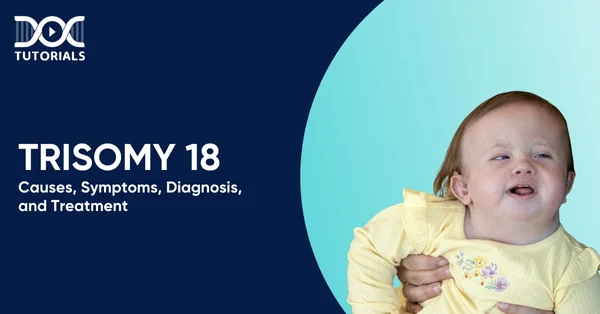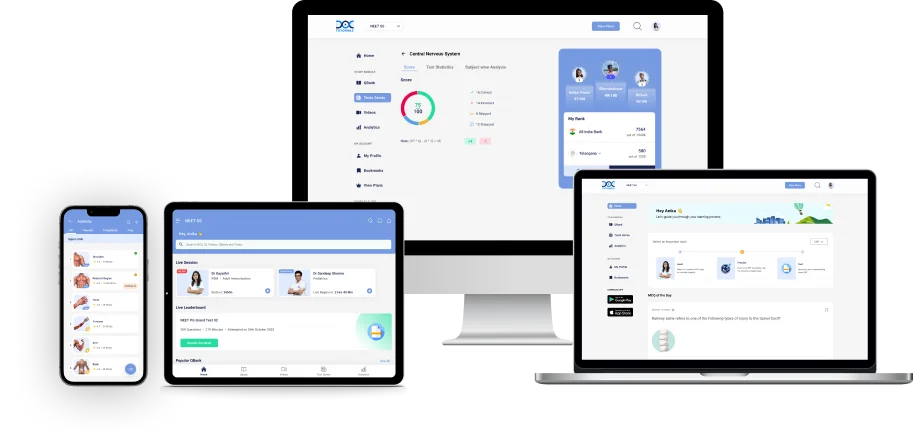Trisomy 18: Causes, Symptoms, Diagnosis, and Treatment

Trisomy 18, or Edwards syndrome, is a rare but serious chromosomal disorder that frequently leads to stillbirth or the premature death of an infant. Although rare, due to its complexity, it is a vital topic for aspiring medical students preparing for the NEET PG exam.
At DocTutorials, complex concepts can be easily understood through in-depth study materials and a well-structured curriculum that helps NEET PG aspirants like you excel in their exams. Keep reading for a detailed insight into Trisomy 18.
What is Trisomy 18?
Trisomy 18, or Edwards syndrome, is a serious genetic disorder resulting from an extra copy of chromosome 18. This is a conception-time chromosomal defect that involves all the cells in approximately 90–95% of cases, whereas 5–10% of babies have a mosaic pattern where only part of the cells possess the additional chromosome.
The condition severely affects normal development, causing low birth weight, weakened organs, and severe developmental delay. Typically, infants with Trisomy 18 have a recognisable appearance, which involves a prominent back of the head, small mouth and jaw, tightly clenched fists with overlapping fingers, and rocker-bottom feet.
Some of the other features can involve small fingernails, redundant folds of skin at the neck, and a shortened breastbone. The syndrome is usually life-threatening, and the majority of affected infants have serious medical issues early in life.
What are the Causes of Trisomy 18?
Edwards syndrome is caused mostly by the presence of an extra copy of chromosome 18 in an individual’s cells. This genetic problem typically happens by chance during egg or sperm formation or soon after fertilisation as a result of cell division abnormalities. In most instances, it is full Trisomy 18, where every cell has an extra chromosome.
What are the Risk Factors of Trisomy 18?
Though Trisomy 18 may occur in pregnancies at any age of the mother, there are certain factors that enhance the risk of this chromosomal abnormality. Listed below are the common risk factors:
- Advanced maternal age (risk rises substantially after 35 years)
- History of earlier pregnancy with trisomy 18, increasing recurrence risk to 0.5%–1%
- Parental chromosomal defects, e.g., balanced translocations
- Random issues in cell division during reproductive cell formation or early embryo development
- Carrying gene fragments associated with partial trisomy 18, which potentially increases the risk in subsequent pregnancies
Although these conditions predispose, the majority occur spontaneously and cannot be predicted or prevented.
What are the Symptoms of Trisomy 18?
Edwards syndrome symptoms manifest with a variety of severe physical malformations and developmental problems, most of which are apparent before or shortly after birth. The following are the main symptoms that are usually found in affected babies:
- Weak growth before and following birth (intrauterine growth restriction)
- Low birth weight and thin appearance
- Compressed hands with overlapping fingers that cannot be straightened
- Rocker-bottom feet
- Palate cleft
- Low-set, abnormally formed ears
- Small head (microcephaly) and prominent back of the head
- Small jaw and mouth (micrognathia)
- Kidney, lung, and gastrointestinal malformations
- Heart malformations, such as atrial septal defect (ASD) and ventricular septal defect (VSD)
- Thumb aplasia
- Radial hypoplasia
- Short sternum
- Hypoplastic nails
- Dorsiflexed hallux
- Short breastbone (sternum) and chest deformities
- Weak sucking and swallowing, leading to feeding troubles
- Weak cry and decreased responsiveness
- Severe delays in development and intellectual disability
- Excess skin folds on the back of the neck
- Cryptorchidism
- Eye or vision problems, such as small eyes, clouding of the corneas, strabismus, etc.
- Hearing loss
- Seizures
What is the Diagnosis of Trisomy 18?
Trisomy 18 (Edwards syndrome) diagnosis takes the form of prenatal screenings, diagnostic testing, and other evaluations. The diagnosis is a combination that verifies an extra chromosome 18 and determines the severity of related physical defects.
Here are the adopted diagnostic methods:
- Prenatal Screening: A cell-free DNA (Deoxyribonucleic acid) test of the blood can be administered after 10 weeks of gestation to detect a high risk of Trisomy 18. However, it does not diagnose the condition.
- Diagnostic Tests: If screening indicates a risk, physicians can conduct CVS (chorionic villus sampling) during the first trimester or second—or third-trimester amniocentesis. These invasive procedures examine foetal cells for chromosomal defects.
- Ultrasound Imaging: An ultrasound at about 12 weeks or more can detect structural defects such as a small head, limb abnormalities, or fists being clenched—all familiar indications of Trisomy 18.
- Postnatal Diagnosis: Physicians can determine Trisomy 18 from its physical characteristics when a baby is born. Subsequently, diagnosis is confirmed through chromosome analysis with a blood sample and can be used to determine the recurrence risk for subsequent pregnancies.
- Genetic Counselling: In the case of a family history or past child with Trisomy 18, it is advisable to see a genetic counsellor to assess future risks as well as reproductive choices.
What is the Treatment for Trisomy 18?
While there is no cure for Trisomy 18, children can get treatment to help manage their specific symptoms and health issues, depending on the choices made by their medical team and family. Here are the common treatment methods:
- Initial Stabilisation: For infants, treatment may involve basic stabilisation, such as support with breathing, feeding, etc., beginning in the crucial first few days after birth.
- Medical Management: Depending on the child’s symptoms, they may need medications, a feeding tube or a breathing apparatus. Feeding problems may be addressed through individualised feeding plans or surgical correction (like cleft palate).
- Surgical Interventions: Some infants with Trisomy 18 could be treated surgically, especially for congenital heart disease or other correctable anomalies, as long as the severity of medical problems permits.
- Palliative and Comfort Care: Many families may choose to provide palliative or hospice care, focusing on comfort rather than aggressive treatment; in this case, quality of life and minimising suffering take precedence over the conventional approach.
- Developmental Support: Medically stable children may be able to access early intervention services, including physical therapy and occupational therapy, to promote development and functional ability.
FAQs About Trisomy 18
- What are the types of Trisomy 18?
Trisomy 18 exists in 3 forms. Full trisomy 18 is the most frequent form, in which all cells in the baby’s body contain an extra chromosome 18.
Another is Partial trisomy 18, which occurs when only a portion of an extra chromosome 18 occurs, usually due to a translocation. The third is Mosaic trisomy 18, which occurs when only some of the baby’s cells contain the extra chromosome.
- What increases the chances of having a child with trisomy 18?
With trisomy 18, there are three copies of chromosome 18 instead of the usual two. Edwards’ syndrome is a random occurrence, and there is no way to prevent it. It can happen suddenly and is unrelated to anything that happened before or during the pregnancy. The likelihoods of having a child with Edwards’ syndrome increase as one ages.
- What is the life expectancy of a child with trisomy 18?
Most babies with trisomy 18 do not survive past the first two weeks of life, and fewer than 10% survive past the first year. A small number may reach their teenage years, but they usually need ongoing care and considerable support for all activities of daily living.
- Is there a treatment approach for trisomy 18?
There is no treatment or cure for the extra chromosome that causes trisomy 18 at this time. The care provided to infants and children diagnosed with trisomy 18 focuses on managing the symptoms associated with their particular condition.
- What is the risk range associated with trisomy 18?
Edwards syndrome, also known as trisomy 18, is estimated to occur in 1 out of every 5,000 to 6,000 live births.
Conclusion
Trisomy 18 is a debilitating chromosomal condition that emotionally affects families, as well as being clinically challenging for healthcare professionals. Although there is no cure, an awareness of its presentation and management is essential in providing empathetic care.
For medical students preparing for competitive examinations such as NEET PG, online resources such as DocTutorials provide an invaluable advantage. Doctutorials make complicated and challenging concepts easy to grasp and deliver testable facts through student-centric, expert-led resources.
Join Doctutorials’ NEET PG course to excel in your NEET PG exam!
Latest Blogs
-

NEET SS Exam 2024: Analysis, Key Dates, Counselling
The NEET SS 2024 exam kicked off on March 29, 2025. Over two days and two slots, candidates across 13…
-

NEET PG Registration 2025: An Essential Guide For Exam Prep
The NEET PG registration, which is conducted online, is a crucial step in the exam process. Filling out the NEET…
-

NEET PG Syllabus 2026: A Must-Have Complete Guide for Exam Success
The NEET PG Syllabus acts as one of the foundation stones for aspiring postgraduate medical students like you who are…




